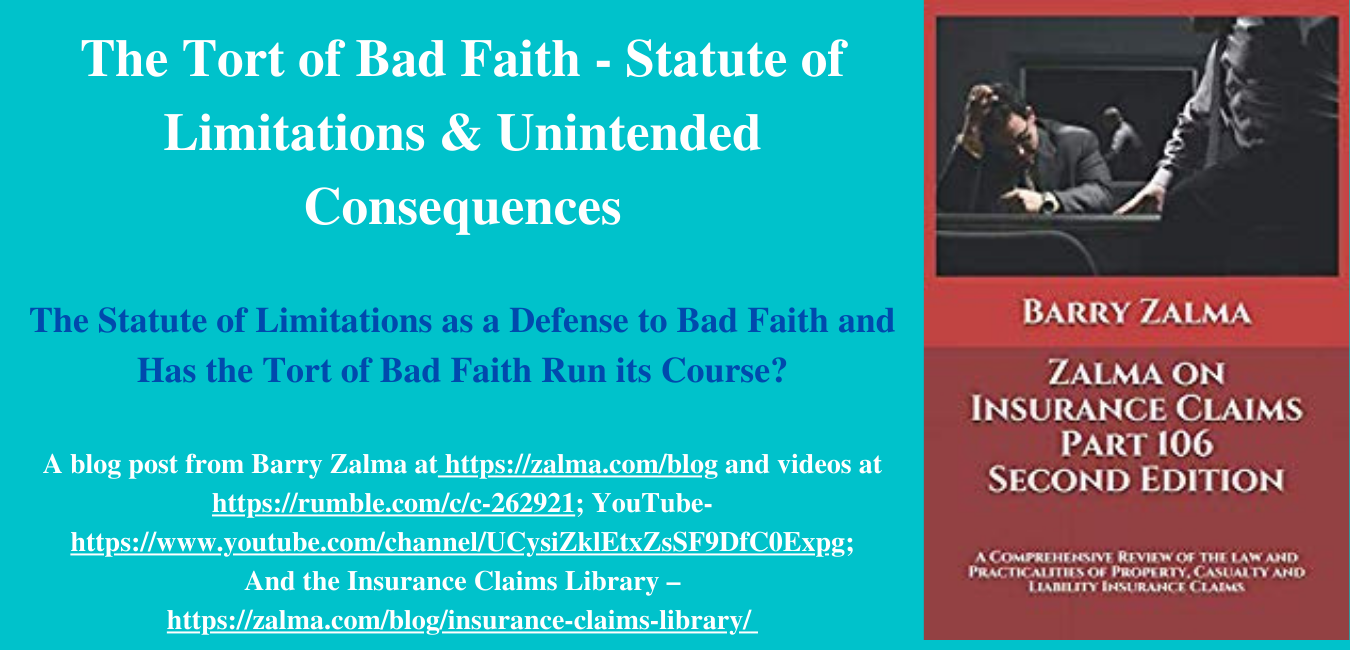-
News Feed
- EXPLORE
-
Pages
-
Groups
-
Events
-
Blogs
-
Marketplace
-
Offers
-
Jobs
-
Developers
Defenses to the Tort of Bad Faith & End of the Tort

A Video Explaining The Statute of Limitations as a Defense to Bad Faith
Read the full article at https://www.linkedin.com/pulse/tort-bad-faith-statute-limitations-unintended-barry-zalma-esq-cfe and see the full video at https://rumble.com/c/c-262921 and at https://youtu.be/H3r2LamnGX8 and at https://zalma.com/blog plus more than 3850 posts.
In West Virginia, for example, a one-year statute of limitations applies to a statutory bad faith claim. Claims involving unfair settlement practices that arise under the Unfair Trade Practices Act, West Virginia Code § 33-11-1 to -10 (1996 & Supp. 1997), are governed by the one-year statute of limitations set forth in West Virginia Code § 55-2-12(c) (1994). [Wilt v. State Auto. Mut. Ins. Co., 203 W. Va. 165, 506 S.E.2d 608 (1998)] .A common law bad faith claim sounds in tort. The statute of limitations that governs a tort action is contained in W. Va. Code § 55-2-12 (1959) (Repl. Vol. 2008).
Has the Tort of Bad Faith Run its Course?
US law was first organized using English common law. When a contract was breached, only contract damages could be recovered. Tort damages were limited to tortious conduct and the two categories of damages were mutually exclusive.
The primary purpose of damages for breach of a contract is to protect the promisee’s expectation interest in the promisor’s performance. Damages should put the plaintiff in as good a position as if the defendant had fully performed as required by the contract. Insurance, like all parts of modern society, is subject to the deprivations of the law of unintended consequences. The law can be defined as the understanding that actions of people—and especially of government or the courts—always have effects that are unanticipated or unintended. Insurance is controlled by the courts, through appellate decisions, and by governmental agencies through statute and regulation. Compliance with the appellate decisions, statutes and regulations—different in the various states—is exceedingly difficult and expensive.
Insurance contracts can be simple or exceedingly complex, depending upon the risks taken by the insurer. Regardless, insurance is only a contract whose terms are agreed to by the parties to the contract. Over the last few centuries almost every word and phrase used in insurance contracts has been interpreted and applied by one court or another. Ambiguity in contract language became certain. However, the average person saw the insurance contract as incomprehensible and impossible to understand. Ostensibly to protect the public, regulators decided to require that insurers write their policies in easy-to-read language. Because they were required to do so by law, insurers changed the words in their contracts into language that people with a fourth grade education could understand. Precise language interpreted by hundreds of years of court decisions was disposed of and replaced with imprecise, easy-to-read language.
We are 100% funded for October.
Thanks to everyone who helped out. 🥰
Xephula monthly operating expenses for 2024 - Server: $143/month - Backup Software: $6/month - Object Storage: $6/month - SMTP Service: $10/month - Stripe Processing Fees: ~$10/month - Total: $175/month
- Art
- Causes
- Crafts
- Crime
- Dance
- Drinks
- Film
- Finance
- Fitness
- Food
- Games
- Gardening
- Health
- Home
- Literature
- Music
- Networking
- Paranormal
- Other
- Politics
- History
- News
- Party
- Science
- Religion
- Shopping
- Sports
- SyFy
- Politically Incorrect
- Philosophy
- Theater
- Technology
- Wellness



